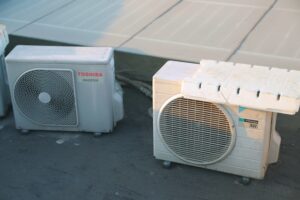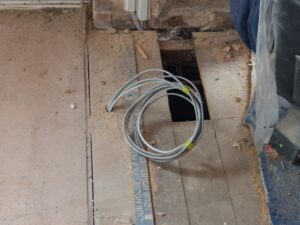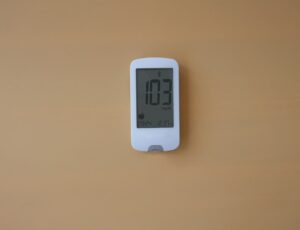Thinking about upgrading your home’s heating and cooling system?
If you’ve noticed your energy bills creeping up or you’re tired of constantly adjusting the temperature, a smart thermostat could be your perfect solution.
These clever devices do more than just adjust your home’s temperature—they learn your preferences, adapt to your routine, and optimize energy usage, offering you both comfort and savings.
Imagine this: You’re at work, and you realize you forgot to turn off the AC. No worries! With a smart thermostat, you can adjust the temperature from your phone, ensuring you save energy while you’re away. When you’re home, it’ll automatically adjust to your ideal comfort level.
How cool is that?
At Excel Mechanical, we make smart thermostat installation easy and hassle-free. We don’t just sell systems; we ensure they’re perfectly integrated into your home, working with your existing HVAC system to deliver top-notch performance.
With our experience and personalized solutions, we’ll help you get the most out of your new smart thermostat, making sure your home stays comfortable all year round, while saving you money.
In this blog, you will learn:
- How a smart thermostat can save you money by optimizing your HVAC system
- The steps involved in installing and integrating your new thermostat
- How to choose the right smart thermostat for your needs and home
Let’s dive in!
Understanding Smart Thermostats
Smart thermostats are modern devices that offer better control over your home’s heating and cooling systems. They save on energy costs and can be accessed via smartphones, making them highly convenient.
Definition and Concept
Smart thermostats are advanced temperature control devices.
Unlike traditional models, they connect to the internet. You can control them remotely using a smartphone or other devices. They learn your schedule by observing your daily routines. This helps them adjust temperatures automatically to keep your home comfortable.
Many smart thermostats come with features like motion sensors. These sensors detect when you’re home or away. Based on this, the thermostat adjusts settings to save energy.
Updates and alerts ensure efficient and effective climate management in your home.
Benefits of Smart Thermostats
Using a smart thermostat brings several advantages.
- One notable benefit is energy savings. By learning your habits, these thermostats make efficient temperature adjustments. This efficiency leads to lower energy bills and a smaller environmental footprint, making your home greener.
- Convenience is another key advantage. You can change settings from anywhere with your smartphone. Imagine adjusting your home’s temperature while sitting at work or on vacation. Smart thermostats keep you informed about your energy use with alerts and reports.
For HVAC and plumbing, we offers expert services. Trust our professionals to integrate the best system tailored to your needs and budget.
How Smart Thermostats Differ from Traditional Models
Traditional thermostats require manual adjustments.
In contrast, smart thermostats offer automated and remote-controlled features. They learn from your schedule and preferences, optimizing energy use and comfort without constant input, making them a more advanced option.
Smart thermostats provide more insight into your energy consumption. With detailed reports, you can monitor and reduce your carbon footprint. They connect with other smart home devices, creating an integrated and user-friendly system.
Pre-Installation Preparation
Before installing a smart thermostat, it’s important to gather the right tools, ensure safety is a priority, check compatibility, and select the right model to meet your needs. Taking the time to prepare can help set up an efficient and reliable home system.
Tools and Materials Required
To start, gather a screwdriver set, a drill, and a level.
These basic tools are essential for safely and correctly installing your smart thermostat. You might also need wire labels and electrical tape.
You can download the companion app for your new thermostat using a smartphone or tablet. Check for a compatible Wi-Fi network, as most smart thermostats rely on internet access for full functionality.
Safety Precautions
Safety must always come first.
To avoid electric shock, turn off the power at the circuit breaker. Use a voltage tester to confirm that the power is off before you begin any wiring. Work in a well-lit area.
If any issues arise, consult a professional.
Determining Compatibility
Check your current wiring system to see if it is compatible with a smart thermostat. Most smart thermostats require a common wire (C-wire) to provide enough power.
Compatibility Check:
- Remove the old thermostat from its base.
- Inspect the wiring to confirm it matches the requirements of the new unit.
- Consult the user manual for specific wiring needs.
Knowing your HVAC system type is also crucial. Your chosen smart thermostat should be suited to your existing heating and cooling setup.
Choosing the Right Model
Choose a smart thermostat that fits your lifestyle and home.
Key factors include ease of use, connectivity options, and integration with other smart home devices.
Excel Mechanical can help you pick the best model for your home. We offer personalized recommendations that meet individual needs and budgets, always aiming for exceptional quality and value.
Installation Process
Setting up a smart thermostat involves carefully removing the old unit, securing a new mounting plate, connecting the wires correctly, and attaching the smart device. Following these steps will ensure proper function and connectivity.
Removing the Old Thermostat
Before you begin, turn off the power to your HVAC system. This prevents any electrical hazards during the process. Use a screwdriver to remove the cover of your old thermostat.
Note how the wires are connected, and take a picture or label them to remember their positions. Carefully disconnect the wires from the old unit, ensuring they do not fall back into the wall.
Once the wires are free, unscrew and remove the old mounting plate from the wall.
Installing the New Mounting Plate
Position the new mounting plate on the wall.
Ensure it is level and aligns with the holes of the previous plate. Use a pencil to mark any new holes you need to drill.
Secure the new plate with screws. If the new plate leaves gaps or the previous holes don’t match, you may need to use drywall anchors for added support.
Ensure the plate is firm and steady, as this forms the base for your smart thermostat.
Connecting the Wires
Identify the labeled wires from your previous thermostat.
Smart thermostats often come with labels to match existing wires. Connect each wire to the correct terminal on the new mounting plate, ensuring they are securely fastened.
You might need to attach a C-wire (common wire) for power.
Attaching the Smart Thermostat
Once the wiring is complete, attach the smart thermostat to the mounting plate.
Align it properly and push it into place until it clicks securely. Check all connections and make sure the unit sits flush against the wall. Turn the HVAC system’s power back on to test the installation.
If everything is connected correctly, the display should light up.
Initial Setup
After installation, you will start the initial setup on the smart thermostat’s interface.
Follow the on-screen instructions to connect it to your Wi-Fi network. Enter information about your HVAC system type and your preferences. Download the corresponding app on your phone to control the thermostat remotely.
For any questions or help, our team offers excellent support for smart home integrations, ensuring your system works perfectly within your budget.
Network Integration
Connecting a smart thermostat to your network enhances its functionality. You can control it remotely, create schedules, and link it with other smart devices. Below are essential steps for proper network integration.
Connecting to Wi-Fi
First, ensure your wireless router is active to connect your smart thermostat to Wi-Fi.
Use the thermostat’s touchscreen to navigate to the settings menu. Look for the Wi-Fi option, select your network name from the list, and enter the password.
Your Wi-Fi signal must be strong where the thermostat is installed. This prevents connection drops. If you face issues, rebooting the router or moving it closer might help.
A stable connection is vital for real-time updates and efficient control.
Creating an Account and Registering the Device
Set up an account with the thermostat manufacturer. This usually involves downloading their app from your device’s app store and following the account creation steps.
Once your account is ready, register your thermostat in the app. This process typically involves entering a code displayed on the thermostat.
Registering the device allows access to features like remote control and system alerts. Ensure you keep your login details secure to prevent unauthorized access.
Integration with Home Automation Systems
Integrating your smart thermostat with home automation systems adds more control options.
Check compatibility with Amazon Alexa, Google Assistant, or Apple HomeKit. Often, this involves linking accounts through respective apps and enabling specific skills or actions. This allows voice commands and other smart interactions.
Make sure your devices are linked correctly to enjoy a more seamless experience.
Configuration and Optimization
Smart thermostats are effective when configured correctly. Learn how to set them up, adjust their settings, and use their features to save energy and cut costs.
Calibrating Sensors
Make sure sensors are accurate to get the most out of your smart thermostat.
Placement is crucial: install sensors away from direct sunlight, vents, or drafts. If readings seem off, recalibrate. Some thermostats have a calibration option in their settings menu. Regular checks can ensure consistent temperature control.
By setting your thermostat’s sensors accurately, you maintain comfort while maximizing energy savings, making your system more efficient.
Setting Up Schedules
Setting a schedule helps manage your home’s climate without manual thermostat changes.
Adjust settings based on your daily routine. Program different temperatures for daytime and nighttime, or when you’re away from home.
Most smart thermostats allow you to create multiple schedules and adjust them seasonally. Look for features like auto-scheduling, which learns your habits.
Using scheduling can lead to noticeable savings on energy bills.
Energy Consumption Tracking
Understanding your energy use is key.
Many smart thermostats provide real-time tracking and show usage trends over time. Check charts or graphs available through the device’s app to evaluate patterns. These insights help identify periods of high energy use, enabling you to make informed adjustments.
By knowing when you use the most energy, you can take steps to reduce consumption and save money.
Learning Features and Smart Setbacks
Some thermostats learn from your preferences and adapt accordingly. These learning features adjust temperatures based on your routine without manual input.
Smart setbacks automatically reduce energy use when you’re not home. For optimal performance, ensure your thermostat settings enable these features. This enhances not only comfort but also energy efficiency.
Choosing Excel Mechanical guarantees expert service and systems optimized for comfort and energy savings.
Maintenance and Troubleshooting
Keeping your smart thermostat in top condition helps it perform better and last longer. This guide covers cleaning tasks, software updates, and common troubleshooting steps.
Regular Maintenance Tasks
Regular cleaning is key to ensuring your smart thermostat functions well.
Carefully clean the exterior by wiping it with a soft, dry cloth. Avoid using water or cleaners, as they might damage it. Check battery levels to see if your model uses them, and replace them when needed.
Connection check is another task. Ensure it remains connected to the Wi-Fi network for seamless operation. Dust around the thermostat and vents can affect performance, so vacuum the area to keep things running smoothly.
Software Updates
Regular software updates benefit smart thermostats. These updates can improve features, fix bugs, and enhance security.
To update, connect the thermostat to Wi-Fi and check the app for available updates. New features may require restarting the device for them to take effect. Automatic updates can be set up for convenience. This ensures your thermostat always has the latest improvements.
Keeping software current is essential for optimal performance and reliability.
Troubleshooting Common Issues
Even with maintenance, issues can arise.
For connectivity problems, restart the device or router and check Wi-Fi settings.
Adjust thermostat settings if heating or cooling seems insufficient. For unresponsive devices, perform a factory reset as a last resort. This resets settings to default, requiring a new setup. Always consult the user manual for specific instructions.
If issues persist, consider contacting professionals. Excel Mechanical offers expert HVAC and plumbing services. Our team ensures your system meets your needs and budget, providing exceptional quality and value.
Advanced Features and Enhancements
Smart thermostats offer many benefits, providing better comfort and energy efficiency. From remote control to integrating with renewable energy, these gadgets are changing how you manage your home’s climate. They even allow the use of voice commands for hands-free operation.
Remote Access and Control
With remote access, you can control your smart thermostat from anywhere using an app. This means you can adjust the temperature while at work or on vacation. It’s not just about convenience; it also helps save energy by turning down the heat or air conditioning when you’re not home.
Being able to monitor and change settings remotely can lower energy bills. You also get real-time updates and notifications, which can alert you to any issues.
Geo-Fencing Technology
Geo-fencing uses your smartphone’s location to manage your home’s temperature.
When you’re almost home, the thermostat can adjust the temperature to your liking. Conversely, when you leave, it can set the system to an energy-saving mode.
This feature minimizes energy waste by heating or cooling your home only when needed. The setup is simple through the thermostat app. You define a virtual boundary around your home, and the system takes care of the rest.
Geo-fencing adds a layer of auto-control, enhancing both comfort and efficiency.
Integration with Renewable Energy Sources
Smart thermostats can work with solar panels and other renewable energy systems.
This integration allows the thermostat to manage and distribute energy more efficiently. You make the most of your renewable resources by aligning your usage with peak solar production.
Choosing Excel Mechanical means benefiting from professional guidance for integrating these systems, ensuring optimal functionality. You’ll achieve better energy efficiency while supporting sustainable practices.
Our team can customize solutions to suit your energy goals and budget.
Using Voice Commands and Personal Assistants
Smart thermostats often support popular voice assistants like Alexa or Google Assistant.
You can adjust settings without even touching the thermostat. Just say a command, like “set the temperature to 70 degrees,” and it’s done.
Voice control adds convenience, especially if you’re busy or your hands are full. These systems typically update automatically, keeping features current and reliable.
Responsible Usage and Environmental Impact
Smart thermostats help you manage energy use efficiently, lower utility bills, and support environmental conservation. These devices make maintaining a comfortable indoor environment easier while reducing energy waste.
Energy Saving Tips
Smart thermostats offer many features to save energy.
- Scheduling is a key tool. Set your thermostat to lower heating or cooling when no one is home, preventing energy waste.
- Learning modes adapt to your habits over time. They adjust settings without you having to do anything.
- You can also use geofencing, which alerts your thermostat to change settings when you leave or return home.
- Remote access via apps is another benefit. You can adjust the temperature from anywhere. Voice control through smart assistants is also possible, adding convenience.
Using these features wisely can significantly reduce energy consumption and carbon footprint.
Impact on Utility Bills
Using a smart thermostat can lead to noticeable savings on utility bills.
You spend less on energy by tailoring heating and cooling to your actual needs.
Monthly savings may vary depending on usage habits, but many users report a 10-15% reduction in energy bills. These savings can offset the initial cost of a smart thermostat over time.
Smart thermostats provide detailed reports that show you how much energy you’re using and when. By analyzing this data, you can make smarter decisions about heating and cooling schedules.
The upfront investment is balanced by the long-term savings they can provide.
Contribution to Environmental Conservation
Smart thermostats contribute to environmental conservation by reducing energy consumption.
This lowers greenhouse gas emissions, helping combat climate change. When excessive energy use decreases, the demand on power plants reduces, resulting in a lower environmental impact.
Choosing a professional service ensures your smart thermostat system is effective and tailored to your home’s needs. Our skilled team strives for exceptional quality and value in HVAC and plumbing services.
By integrating these systems effectively, Excel Mechanical helps you get the most out of your smart thermostat for comfort and sustainability.
Frequently Asked Questions
If you’re thinking about upgrading your home with a smart thermostat, you probably have a few questions. Don’t worry, we’ve got you covered! From installation concerns to long-term benefits, here are some answers to help you make the most out of your new smart thermostat and ensure it’s the perfect fit for your home.
How can I install a smart thermostat without a C wire?
If your system doesn’t have a C wire, you can use an adapter or choose a smart thermostat that doesn’t require one. Some thermostats have built-in batteries or use power-stealing technology.
What should I consider before installing a smart thermostat?
Check your HVAC system’s compatibility; not all systems work with smart thermostats. It’s important to consider Wi-Fi reliability in your home and assess your comfort with the technology setup.
Are there any disadvantages to using a smart thermostat in my home?
Smart thermostats may require a stable internet connection to function properly. Some users find that their systems take time to learn preferences, but they can save on energy costs.
Can I replace my existing thermostat with a smart thermostat on my own?
Many smart thermostats are designed for DIY installation with step-by-step guides. Before starting, make sure to turn off the power. If unsure, consider professional help to avoid damage.
What is the typical cost for professional smart thermostat installation?
Professional installation costs can range from $100 to $250, depending on the complexity of your HVAC system. Choosing a reliable service ensures smooth installation and optimal performance.
What steps are involved in the integration process for a smart thermostat with other home automation systems?
Start by checking compatibility with your home automation system. Then, use the smart thermostat’s app to connect with other devices. This process often involves connecting through Wi-Fi or Bluetooth.




